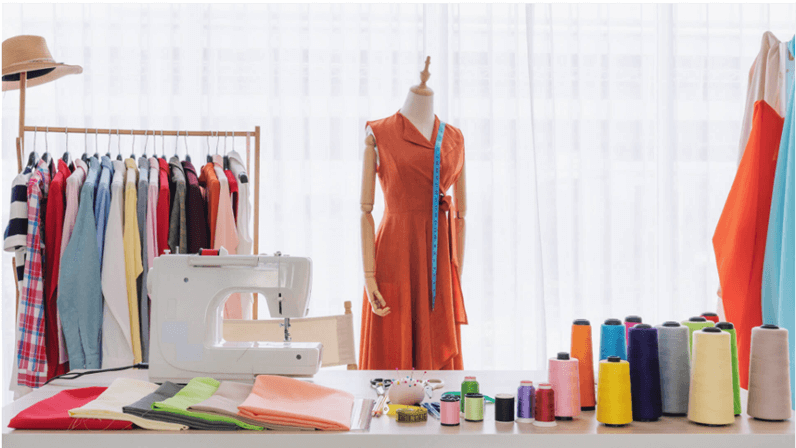Are you passionate about fashion and dreaming of starting your own clothing business?
Knowing how to start a clothing business is the first step toward achieving your entrepreneurial dreams.
The clothing business is thriving and rising year after year. According to Statista, the retail e-commerce business is currently valued $102.5 billion and is expected to grow to $153.6 billion by 2024.

How to start a clothing business – Step by Step Guide
If you have a passion for fashion, starting a clothing business could be a terrific way to put your skills and creativity into a job. It’s easier than ever for new business owners to sell their items online and make a profit.
In this guide, we will explore how to start a clothing business, from conceptualizing your brand to creating your products and ultimately selling them to your target audience. So, let’s dive in and discover how to start a clothing business in 2023.
1. Identify Your Niche
The most crucial decision when starting a clothing business is deciding what niche your business should serve. This will assist you in developing a product line that resonates with your target market and in developing a strong brand.
- Identify your expertise and areas of passion within the clothing industry, such as fashion design, graphic design, or fabric selection.
- Analyze what is popular and in demand to find a gap or untapped niche in the market.
- Identify your unique selling proposition and determine what sets your online store apart from competitors. It could be your design aesthetic, high-quality materials, affordable pricing, or personalized customer experience.
- Create a cohesive brand image and messaging that aligns with your niche. Your branding should resonate with your target audience and clearly communicate the value you provide.

2. Identify Your Audience
It’s important to identify your ideal customer early on. When it comes to building your business, fashion makes things both easier and more difficult. You can easily conceive who might wear your goods, but you also need to figure out where they hang out (in physical stores and online) and how to approach them.
Here are some questions to think about when defining your target audience:
- Who exactly are they?
- Which clothes brands do they prefer?
- Do they have a preference for certain brands?
- Where do they go shopping?
- How frequently do they go shopping?
- Do they care about fashion?
- What factors influence their purchasing decisions?
You will better understand your target audience by answering these questions. This allows you to build your brand more strategically, create things they’ll want, and distribute products so they’re easily discoverable by the individuals who will buy them.
3. Analyze Fashion Trends
Examine current fashion trends carefully and pick which ones you wish to replicate.
- Stay updated with industry by regularly reading fashion blogs and online publications that cover the latest trends, runway shows, and fashion news.
- Follow influential fashion bloggers, social media influencers, and celebrities who are known for their fashion sense. Observe the styles they showcase and the trends they endorse.
- Keep an eye on popular social media platforms like Instagram, Pinterest, and TikTok. Pay attention to hashtags, user-generated content, and trending fashion topics.
- Attend local fashion events, runway shows, and trade shows to get a firsthand look at emerging trends, new designers, and industry insights.
- Subscribe to trend forecasting services or use online platforms that provide insights into upcoming fashion trends. These resources analyze consumer behavior, cultural shifts, and design influences.

4. Create a Business Plan
A business plan serves as a roadmap for your clothing brand’s success. It should be well-researched, concise, and realistic. It should involve the following key steps:
- Provide a concise overview of the clothing brand, its mission, and key highlights of the plan.
- Describe the background and unique identity of the clothing brand.
- Conduct research on the fashion industry and target market to understand demographics, preferences, and competition.
- Outline the clothing product line, including design, sourcing, pricing, and market positioning.
- Define marketing and branding strategies to reach the target audience, and outline sales channels and customer acquisition plans.
- Explain the operational structure, team roles, production, inventory management, and quality control measures.
- Create a financial forecast, including sales projections, expenses, and profitability estimates.
- Define the steps required to launch and grow the clothing brand, including timelines and milestones.
5. Come Up With a Unique Name
If you don’t already have a business name in mind, now is the time to come up with one. Clothing business names can vary greatly.
Here are a few pointers to consider while naming your clothing business:
- Make sure it is simple to say and spell.
- Choose a distinctive or catchy name.
- Consider how it would translate into different languages.
- Check to see if it is available as a domain name on GoDaddy or NameCheap (for example, yourbusinessname.com).
6. Create Brand Assets
Once you’ve decided on a business name, design a slogan (optional), a brand color scheme, and a logo. Your logo will be an important part of your brand. You might end up incorporating it in your designs or featuring it prominently on your social media channels.
You can use a free design tool such as Canva to create your business logo
- Create your free account on Canva.
- Choose a logo template or start with a blank canvas.
- Customize the template by editing text, colors, fonts, and other design elements.
- Experiment with additional design elements like shapes, lines, and backgrounds.
- Incorporate your brand elements, such as your brand name or tagline.
- Preview the logo in different sizes and formats.
- Download and save the logo in your preferred file format (e.g., PNG or SVG).
- Implement the logo across your branding materials.
Alternatively, you can acquire a professionally designed logo for as little as $5 on Fiverr
- Sign up or log in to Fiverr and search for “logo design” services.
- Select a service provider offering logo design for $5.
- Place an order and provide the necessary details, such as your business name, industry, and any specific requirements.
- Review the initial logo design drafts provided by the service provider.
- Request revisions or modifications until you are satisfied with the final design.
- Approve the logo design and receive the completed files. After that, complete the payment process.
7. Register Your Business
Once you have chosen a brand name and created your brand assets, the next step is to register your business with your state. It is a vital step, even for fresh new clothing enterprises, because you will need an Employer Identification Number (EIN) to collect payments for your products. To obtain an EIN, you must first register as a business. It also allows you to receive wholesale rates and work with retailers.
The process of registering your business varies by state, but you will register it with your state’s Secretary of State. Small businesses often choose to incorporate as a Limited Liability Corporation (LLC), which costs roughly $100 on average but can range between $40 and $250.
The Best LLC Services of 2023 that you can use to register your business are mentioned below:
- ZenBusiness: Best for New Businesses
- LegalZoom: Best Overall
- Incfile: Best for Basic Legal Needs
- Rocket Lawyer: Best for Usability
- Active Filings: Best for International Entrepreneurs
- Swyft Filings: Best Value for Basic Plan
- Northwest Registered Agent: Best for Affordability
- Filenow: Best for Fast Processing
- Inc Authority: Best for Free LLC Formation
8 Pick your price point for products
When selecting a pricing point for your clothing business, the following steps should be considered:
- Calculate the Cost of Goods by determining the costs of materials, labor, and production.
- Evaluate the overhead costs involved in running the clothing line, including warehouse rent, shipping charges, and employee salaries.
- Determine the desired profit margin that covers both direct costs and overhead expenses while allowing for a reasonable profit.
- Research the market and analyze competitors’ pricing strategies, target audience, and market demand.
- Consider the perceived value of your clothing items based on factors like brand reputation, quality, design, and customer service.
- Monitor sales, profit margins, and customer feedback to adjust pricing over time.
- Explore value-added services that can justify higher prices and differentiate your clothing business.
- Regularly analyze and compare pricing with competitors to remain competitive.
- Seek customer feedback to understand their perception of value and satisfaction with the pricing.
Remember to regularly re-evaluate your pricing strategy to ensure it aligns with business goals, covers costs, provides a reasonable profit, and remains attractive to your target customers.
9. Design and Source Your Products
You most likely already know how you intend to develop and obtain your products. However, if you’re undecided or open to new ideas, there are three primary options:
- Purchase things from wholesalers.
- Create your own and get them made.
- In-house design and sewing
Of course, your selection will be determined by how you want to sell your products. For example, if you intend to curate apparel collections to sell online, such as directly through your website or on Amazon, you could choose to buy things from wholesalers or drop shippers.
This is a terrific approach to keep your startup costs minimal, especially if you sell drop shipped products. However, this implies that your products are not as unique and may require more marketing.
10. Set Realistic Sales and Distribution Goals
You know the old saying, “Rome wasn’t built in a day.” The same applies to everyone who has mastered the art of how to start a clothing business.
Set reasonable goals to make it easier for yourself. It is unrealistic to expect to make a million dollars in your first year (though it is conceivable!).
A more attainable aim might be to increase revenue by 20% every quarter for the first year of operation.
If you’re wondering how to create a fashion line that sells in other places, the same applies for distribution. Begin to find a few excellent distribution partners in your first year, then expand incrementally from there.
11. Market Your Clothing Brand
Finally, you must market your clothing business so your target audience can find it. There are numerous methods for marketing a clothing business, but ultimately you want to select marketing channels that reach your specific target market. To put it another way, go where your prospective clients are.
Here are some of the most prominent apparel brand marketing channels and strategies:
- Organic social media marketing (e.g., Pinterest, Instagram)
- Paid social media advertising (e.g., Facebook Ads, YouTube Ads)
- Paid search advertising (e.g., Google Ads)
- Forums (e.g., Reddit)
- Content marketing
- Influencer marketing
- Paid placements
- Banner ads (e.g., Google Adsense)
- E-commerce ads (e.g., Amazon Ads, Etsy Ads)
- Search Engine Optimization (SEO)
- Email marketing
- Sponsorships
- Local events
- Local news
When deciding on the best marketing methods and platforms for your clothing business, always keep your brand in mind. Consider whether it is consistent with your brand and whether it is a wise use of your marketing budget. You’ll want to use numerous marketing channels for optimum visibility, just like using multiple distribution methods.
Is the clothing business still profitable in 2023?
In 2022, the revenue of the global apparel market reached 1.5 trillion U.S. dollars, and the industry is forecast to show positive growth. Revenue is estimated to rise to almost 2 trillion dollars by 2027.
This indicates that there is still significant potential for profitability in the clothing industry. Additionally, with the rise of e-commerce and online shopping, small clothing businesses have easier access to a global customer base and can effectively compete with larger established brands.
By leveraging digital marketing strategies, social media platforms, and e-commerce platforms, clothing entrepreneurs can reach and engage their target audience more effectively, contributing to the profitability of their business in 2023 and beyond.

Frequently Asked Questions
How much does it cost to start a clothing line?
Like any business of any size, the startup costs will depend on how large you want the business to start out. A small clothing business will need about $500, a medium-sized line between $1,000 and $5,000, and a large line might need up to $50,000.
Are clothing businesses typically profitable?
With hard work and devotion, it can be. Estimates state that profits can be anywhere from 4% to 13%. There will likely be many changes because fashion cycles through trends so quickly.
Do I need a business plan to start a clothing business?
While you don’t exactly need a business plan to start a clothing business, it’s a good idea to create one. The reason being is having a strong business plan will help you stay true to your original vision. Planning out your suppliers, goals and general growth plan will set you up for success in the future.
Where can I get products for my online store
You can get products for your online store from a variety of sources, including wholesalers, manufacturers and distributors. Another good place to find clothes are thrift stores and garage and yard sales, where you can find gently used clothing and sometimes clothes that have never been worn. Popular aggregators of manufacturers include Alibaba and DHgate. Many store owners use sites like Faire or Abound for wholesale products.
Conclusion
You should have a solid understanding of what it takes to learn how to start a clothing business by now.
The most important thing to remember is that you won’t become a millionaire overnight. You’ll need to regularly test new things, keep track of your progress, and change what isn’t working.

